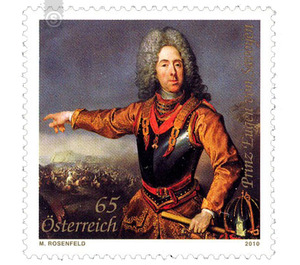personalities - Austria / II. Republic of Austria 2010 - 65 Euro Cent
Theme: Art & Culture
| Country | Austria / II. Republic of Austria |
| Issue Date | 2010 |
| Face Value | 65.00 |
| Edition Issued | 200,000 |
| Printing Type | offset |
| Stamp Type | Commemorative |
| Item Type | Stamp |
| Chronological Issue Number | 2190 |
| Chronological Chapter | OOS-OE2 |
| SID | 893800 |
| In 55 Wishlists | |
To a certain extent a philatelic companion - this is the new special stamp, which was presented on the occasion of the big exhibition "Prinz Eugen - Feldherr Philosopher. The Noble Knight as Cultural Heroes "(February 12 to June 6, 2010, Lower Belvedere and Orangery), published by the Austrian Post. She commemorates one of the historically most important personalities of this country. The stamp motif shows an impressive portrait painting by the imperial court painter Jacob van Schuppen, dated after 1717 (original size 130 x 50 cm, oil on canvas, on loan from the Rijksmuseum Amsterdam). About the person: Italian descent, but from birth a Frenchman, Prince Eugene of Savoy (1663-1736) was after his meteoric rise and his illustrious career as a commander of one of the most influential Austrians, who sustained the fate of the country and its art and cultural history coined. As a diplomat and adviser to Emperor Leopold I, Josef I and Charles VI. He traveled from one theater of war to the other across Europe and played a decisive role in the future of the House of Habsburg. The Viennese Belvedere with two castles and a baroque garden, built at the beginning of the 18th century by Johann Lucas von Hildebrandt as summer residence for Prince Eugene of Savoy, is now the scene of the exhibition mentioned at the beginning, which the prince not only as a general, but also as a statesman and patrons of the arts and sciences presented. Throughout his life he devoted himself to the construction of an extensive collection of paintings and engravings, incunabula, illuminated manuscripts and books, which were presented in his palace in Vienna. From the changing theaters of war, Prince Eugen corresponded with artists and artisans, garden architects, master builders and the leading minds of his time. His acquisitions wrote Austrian art and cultural history and forced the transfer of art from the court of the French King Louis XIV to Vienna. The prince's interest in natural science, which was advised in these matters by the philosopher and scientist Gottfried Wilhelm Leibniz, can be seen in his large collection of exotic animals and plants. In the exhibition, exhibits of his art collections, mainly paintings of the Turin Galleria Sabauda and Zimelien the Bibliotheca Eugeniana, are presented, based on the original room decorations. The visitor is thus provided with the complex equipment of the buildings in which Prince Eugen, as President of the Hofkriegsrat and member of the Secret State Conference, received the highest guests, such as the Ambassadors of the Ottoman Empire, for an audience.


